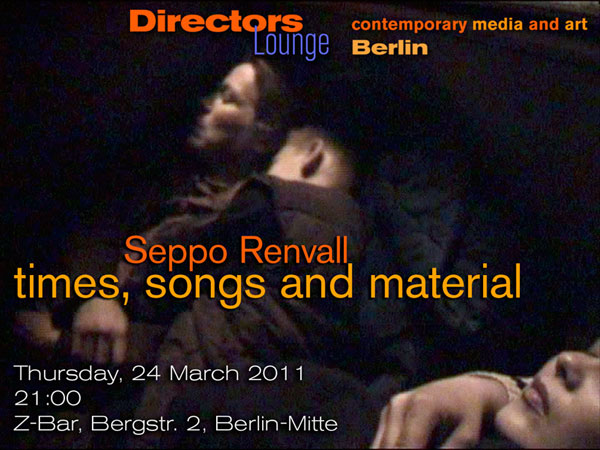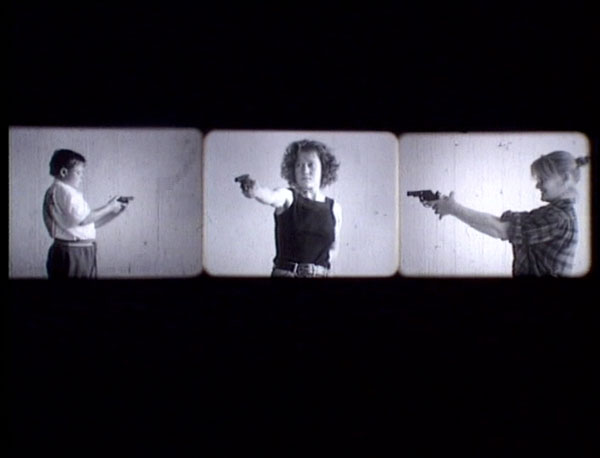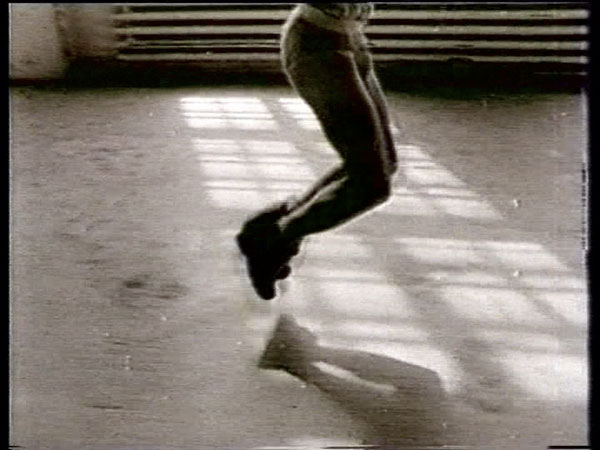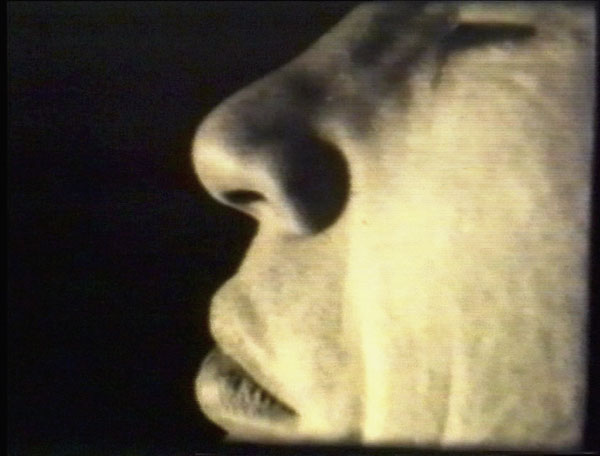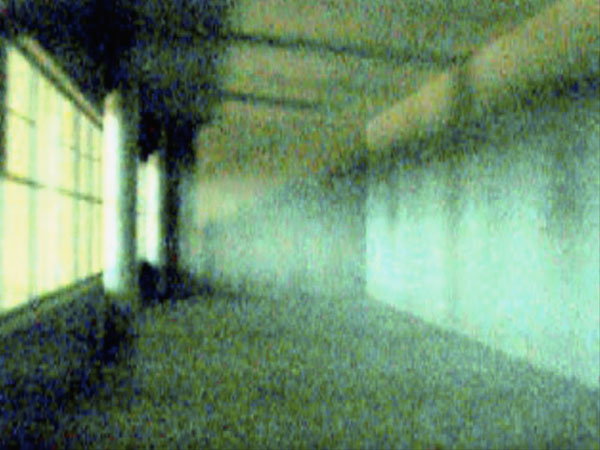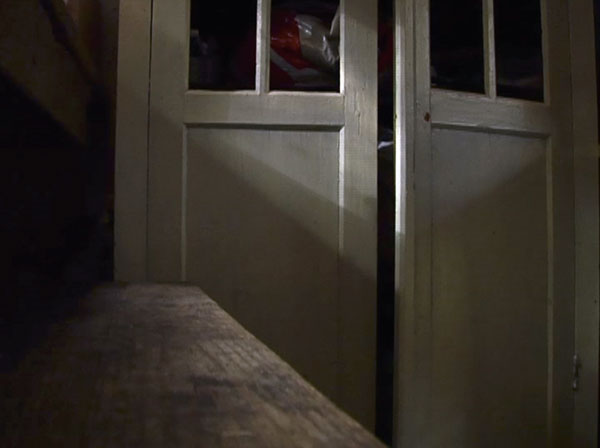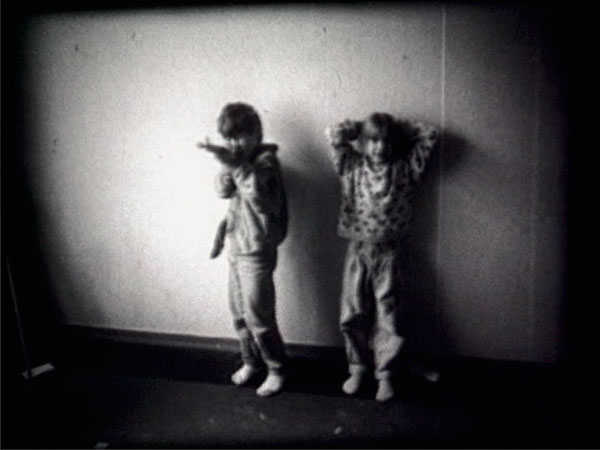 |
directors lounge monthly screening series at z-bar
seppo renvall
times, songs and material
16mm films and video
Donnerstag, 24.03.2011
21:00
Z-Bar
Bergstraße 2
10115 Berlin-Mitte
Times, Songs and Material
Zeiten, Songs und Material
“Nie wirklich gute technische Qualität", “kein scharfes Bild", “kein Stativ", “keine singuläre Idee" — wenn man diese Notizen zu seinen eigenen Filmen liest, könnte man denken, Seppo Renvall praktiziert eine Art Anti-Ästhetik. Und wenn man nur kurz in die derzeitige Ausstellung seiner Werke in die Galerie Suomesta schaut, könnte man dies womöglich bestätigt finden. Schauen wir jedoch genauer hin, merkt man, dass seine Arbeiten keine Anti-Ästhetik verkörpern, keine Skandale sollen hier provoziert werden. Stattdessen ist des Künstlers “Negativität" gegen die große Geste gerichtet, die die Medien dominiert, und gegen die Superlativen des "Meisten", der “Besten" und des “Höchsten", die von der Kunstszene erwartet werden. Theodor W. Adorno benutzte den Ausdruck Negativität im Zusammenhang mit (künstlerischem) Widerstand und mit einer Haltung, die Versöhnung mit dem Bestehenden, d.h. der Affirmation mit Machtverstrickung oder mit dem “Falschen" nicht erlaubt. Seitdem haben sich die Zeiten geändert, diese Gesellschaft erfordert nicht mehr ein Leben in Alarmbereitschaft (W. Benjamin), sondern forciert ein Leben in Aufregung. Seppos Negativität erscheint daher sanfter, scheint eher als Schutzschild zu wirken, oder als Subversion gegen die ständige Erregung, die sowohl die Medien als auch die Kunstwelt von Kunst und Künstlern erwartet.
“Wenn etwas besonders Interessantes passiert, entscheide ich mich vielleicht in die entgegengesetzte Richtung zu filmen", und hier findet Seppo häufig etwas Sprechenderes als das Spektakel, das sich vor ihm entfaltet. Seine Sympathie gilt den unbedeutenden Dingen, oder vielleicht sollte ich sagen, Empathie. Seine Filme tragen seine Empathie mit den “kleinen" Situationen im Leben. In logischer Konsequenz besteht ein Teil seiner Arbeit aus “Homemovies", welche Freunde, Familienleben, Kinder und Reisen zeigen, gedreht und präsentiert auf 16mm.
Die Themen seiner Filme sind auch dann verknüpft mit dem täglichen Leben, wenn sie das “Spektakel" umfassen, wie bei “Nonstoppampam". In diesem (im Original) 3-channel Video werden in schneller Reihenfolge Pistolenschüsse abgefeuert. Vielleicht müssen wir wissen, dass die gefilmten Leute zum ersten Mal im Leben mit einer echten Waffe schießen, um zu sehen, in was S. Renvall am meisten interessiert war: das Staunen, das Zögern, den Zwang und die Überraschung über den Rückschlag, die sich in den Gesten und in den Gesichtern derjenigen spiegeln, die hier “in echt" etwas ausführen, was uns sonst von den Protagonisten, mit denen wir sympathisieren, im Fernsehen täglich vorgespielt wird. Im Film “Iris and Nalle" (Welt Premiere) andererseits bereitet sich ein Pärchen auf einer Bühne auf eine S/M-Show vor, aber “es passiert nichts". Seppo läßt sein Publikum in der unerfüllten Erwartung verweilen, während die Gesten zwischen Mann und Frau vielleicht mehr über die Beziehung und über die Bühnensituation aussagen, als der “wirkliche" Akt es könnte.
Selbst wenn er Found Footage benutzt, oder Photographien aus einem Buch, wie bei “The Price of Our Freedom", ist Seppo an den kleinen Leuten interessiert. Indem er jedem abgebildetem, im Winter 1939/40 gefallenen Soldaten ein 1/25 einer Sekunde gibt — abgebildet in einem Buch über die “Helden" des Krieges gegen die Sowjetunion — und sie dadurch sowohl ineinanderblendet, als auch jedes Gesicht sichtbar bleibt, stellt der Künstler die Frage nach dem Preis für dieses Ereignis neu; (der Krieg wird als nationenbildend angesehen, nach einer Zeit in der Finnland gespalten war in weiße und rote Bürgerkriegsfraktionen.) Dagegen zeitgenössischer, zeigt “Drum Zymphony" sowohl virtuelle als auch dreidimensionale Architekturmodelle von im letzten Jahrzehnt in Helsinki gebauter Architektur, während er auf dem Soundtrack eine Komposition aus Straßenmusik-Aufnahmen aus Helsinki spielt. Der Film, der die Architekturmodelle geradezu zum Leben erweckt, spricht auch von dem Widerspruch zwischen der urbanen Entwicklung der am schnellsten wachsenden Metropole Westeuropas und der marginalisierten Kultur der Straßenmusiker, die in der Kälte bleiben. “Exotique" und “Yötähteni" erzählen von Zwischenräumen, zwischen Licht und Schatten, Tag und Nacht, Unbewußtem und Wachem. In Kombination mit der Musik von Aslak Christianson und anderen Musikern, werden viele der Filme (Super-8 und 16mm), die zumeist auf Video geschnitten sind, zu Liedern über das Leben, zu Rhapsodien, und zur Kritik des allgegenwärtigen Spiegels des Lebens, den das Fernsehen für uns geworden ist.
Kuratiert von Klaus W. Eisenlohr
Mit Unterstützung der Suomesta Galerie, Berlin
Programm:
16mm
Home Movies part 4 1996 2:00
Home Movies parts 1-3 1996 7:00
Private Area 1996 3:49
Video
The Price Of Our Liberty 1990 08:09
Warm Front 2002 5:24
Iris And Nalle 1996 2:53
Planet Earth Encyclopedia 1995 6:13
Dancing Shortly 1993 1:13
Exotique 2009 09:57
Dancing Shortly II 1994 2:45
Drum Zymphony 2004 21:15
Nonstop PamPam 1992 4:20
Yötähteni 2002 2:30
Artist's Links:
Seppo Renvall at FixC
Press Links:
Suomesta Galeria
Z-Bar - http://www.z-bar.de/
Directors Lounge Magazine
http://www.directorslounge.net
 Back Back
|
 |
